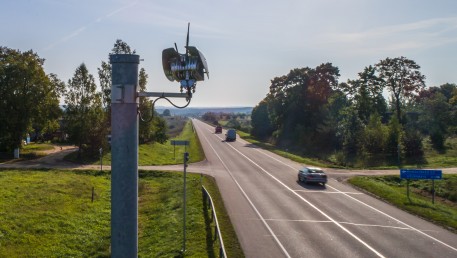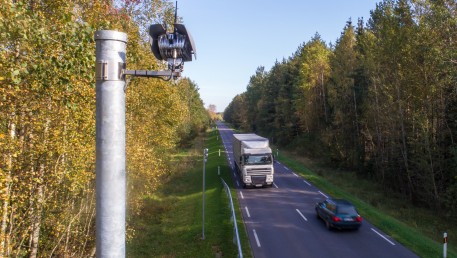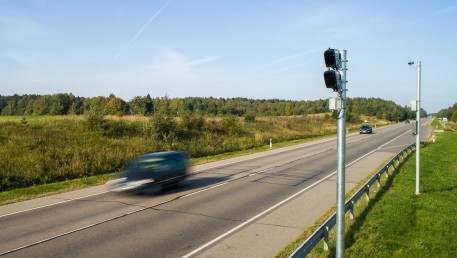
First average speed enforcement system in the Baltics States
- Client Lithuanian Road Administration under the Ministry of Transport and Communications of the Republic of Lithuania
- Implementation period 2017-2018
- Project location Lithuania
- Project partners Jenoptik
- Project task To install a speed control system which ensures that traffic stays at a safe speed in areas where there is a higher concentration of accidents.
Solutions in this project
- Speed metering system
- Data transmission and communication system
- Power supply solutions
FIMA installed an average speed control system, the first system of its kind in the Baltic countries, on 25 sections of road in Lithuania.
FIMA, in cooperation with its technology partner, Jenoptik, designed and installed an average speed measurement system to control the speed of vehicles on 25 sections of road over a total distance of 110 km.
The system consists of hi-tech, specialised video cameras, which can recognize vehicle number plates. The speed cameras operate autonomously without the need for any additional devices embedded in the road surface, external radars or lasers.
When a vehicle passes one of the average speed measurement system’s (ASMS) control points, its number plate is captured, the time of entry and exit from the controlled road section are recorded and the vehicle’s average speed is calculated. If the average speed of the vehicle over the section exceeds the permitted speed, all data necessary for the establishment and prosecution of the violation is automatically recorded by the ASMS control post and transferred to the central information system for further processing.
The system stands out for its high degree of functionality: it is able to recognise number plates issued in more than 120 countries, the cameras have two autonomous clocks ensuring that its measurements are accurate, there are efficient three-light sensor systems, data encryption, and alerts in case of vandalism.
During the project implementation, FIMA prepared all of the infrastructure needed to erect the equipment, installed the average speed information system and designed and installed interfaces between the information system and the data transmission system. The information system performs the following key functions: calculation of vehicle average speed, camera maintenance, statistics, analysis and the transmission of data regarding speeding offences to the Register of Administrative Offences.
The project was up and running within 10 months which is a record.
Related projects
-
 Installation of railway systems on the Vilnius bypass section Pušynas–Paneriai
Installation of railway systems on the Vilnius bypass section Pušynas–Paneriai
-
 Installation of intelligent transportation systems on road E67
Installation of intelligent transportation systems on road E67
-
 Fire protection system of the Lithuanian Central State Archives
Fire protection system of the Lithuanian Central State Archives
-
 Speed enforcement and display equipment in Smiltenė
Speed enforcement and display equipment in Smiltenė
-
 Public transport priority system near Kaunas railway station
Public transport priority system near Kaunas railway station
-
 Traffic control systems at Minsk crossroads
Traffic control systems at Minsk crossroads
-
 Installation of traffic information system in Lithuania
Installation of traffic information system in Lithuania
-
 Set-up and maintenance of a speed enforcement network
Set-up and maintenance of a speed enforcement network





